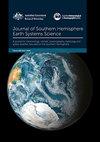Analysis of within and between-GCM uncertainties of runoff projections in Mediterranean-like catchments
IF 3.6
4区 地球科学
Q1 Earth and Planetary Sciences
引用次数: 0
Abstract
Streamflow reductions have been reported in mid-latitude Southern Hemisphere (SH) catchments, in particular in the southwest of Western Australia (SWA) and in central Chile (CC), following decreases in precipitation since the mid-1970s. Although projections from Global Climate Models (GCMs) indicate the observed trends are expected to continue during the rest of the 21st century, they are affected by large uncertainties that challenge informed decision making. Quantification and comparison of uncertainties in runoff projections for the period 2050-2080 relative to 1970-2000, driven by an ensemble of a single GCM with perturbed physics (CPDN) and a multi-model ensemble of different GCMs (CMIP5), were used to account for what we term “within-GCM” and “between-GCM” uncertainty in SWA catchments. Between GCM uncertainty of runoff projections was also quantified in CC catchments. Within and between-GCM uncertainties were found to be very similar (∼55 per cent) in SWA catchments. Between-GCM uncertainty for runoff projections in CC catchments is smaller than in SWA. On average, uncertainty of about 51 per cent, under RCP8.5 scenario, was simulated for the period 2050-2080 compared to 1970-2000. For CC catchments a dichotomy was observed in runoff projections under the RCP4.5 scenario, which according to our preliminary analysis might relate to how ozone is specified within different GCMs. We conclude that the number of models sampled by the CMIP5 ensemble, which includes multiple model runs from some GCMs, provides some insight into within-GCM uncertainties. Furthermore, since CMIP5 model runs report values for all regions and are easily accessible, the CMIP5 ensemble is more convenient for regional hydrological assessments than the perturbed physics experiments.地中海类流域径流预测的gcm内和gcm间不确定性分析
据报道,自20世纪70年代中期以来,随着降水减少,中纬度南半球(SH)集水区,特别是西澳大利亚州西南部和智利中部(CC)的流量减少。尽管全球气候模式(GCMs)的预估表明,观测到的趋势预计将在21世纪剩余时间内继续,但它们受到很大的不确定性的影响,对知情决策构成挑战。在单一GCM与扰动物理(CPDN)和不同GCM的多模式集合(CMIP5)驱动下,对2050-2080年径流预测的不确定性进行了量化和比较,以解释SWA流域“GCM内”和“GCM之间”的不确定性。在GCM之间,还量化了CC流域径流预测的不确定性。发现SWA流域在gcm内和gcm之间的不确定性非常相似(约55%)。CC流域径流预测的gcm间不确定性小于SWA流域。与1970-2000年相比,在RCP8.5情景下,2050-2080年期间的不确定性平均约为51%。对于CC流域,在RCP4.5情景下的径流预测中观察到二分法,根据我们的初步分析,这可能与如何在不同的gcm中指定臭氧有关。我们的结论是,CMIP5集合采样的模式数量,包括来自一些gcm的多个模式运行,提供了一些关于gcm内部不确定性的见解。此外,由于CMIP5模型在所有区域运行报告值,并且易于获取,因此CMIP5集合比扰动物理实验更便于区域水文评估。
本文章由计算机程序翻译,如有差异,请以英文原文为准。
求助全文
约1分钟内获得全文
求助全文
来源期刊

Journal of Southern Hemisphere Earth Systems Science
Earth and Planetary Sciences-Oceanography
CiteScore
8.10
自引率
8.30%
发文量
0
审稿时长
>12 weeks
期刊介绍:
The Journal of Southern Hemisphere Earth Systems Science (JSHESS) publishes broad areas of research with a distinct emphasis on the Southern Hemisphere. The scope of the Journal encompasses the study of the mean state, variability and change of the atmosphere, oceans, and land surface, including the cryosphere, from hemispheric to regional scales.
general circulation of the atmosphere and oceans,
climate change and variability ,
climate impacts,
climate modelling ,
past change in the climate system including palaeoclimate variability,
atmospheric dynamics,
synoptic meteorology,
mesoscale meteorology and severe weather,
tropical meteorology,
observation systems,
remote sensing of atmospheric, oceanic and land surface processes,
weather, climate and ocean prediction,
atmospheric and oceanic composition and chemistry,
physical oceanography,
air‐sea interactions,
coastal zone processes,
hydrology,
cryosphere‐atmosphere interactions,
land surface‐atmosphere interactions,
space weather, including impacts and mitigation on technology,
ionospheric, magnetospheric, auroral and space physics,
data assimilation applied to the above subject areas .
Authors are encouraged to contact the Editor for specific advice on whether the subject matter of a proposed submission is appropriate for the Journal of Southern Hemisphere Earth Systems Science.
 求助内容:
求助内容: 应助结果提醒方式:
应助结果提醒方式:


